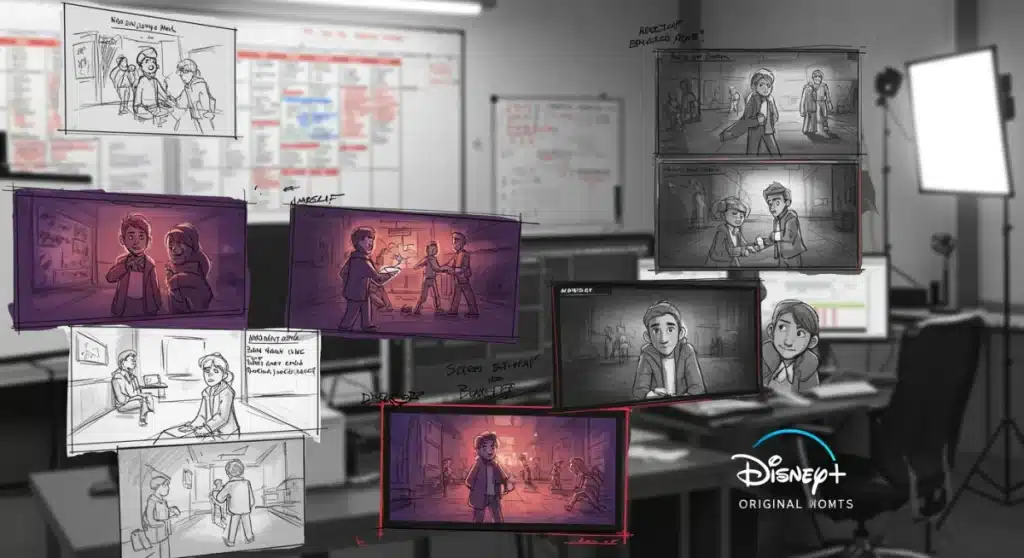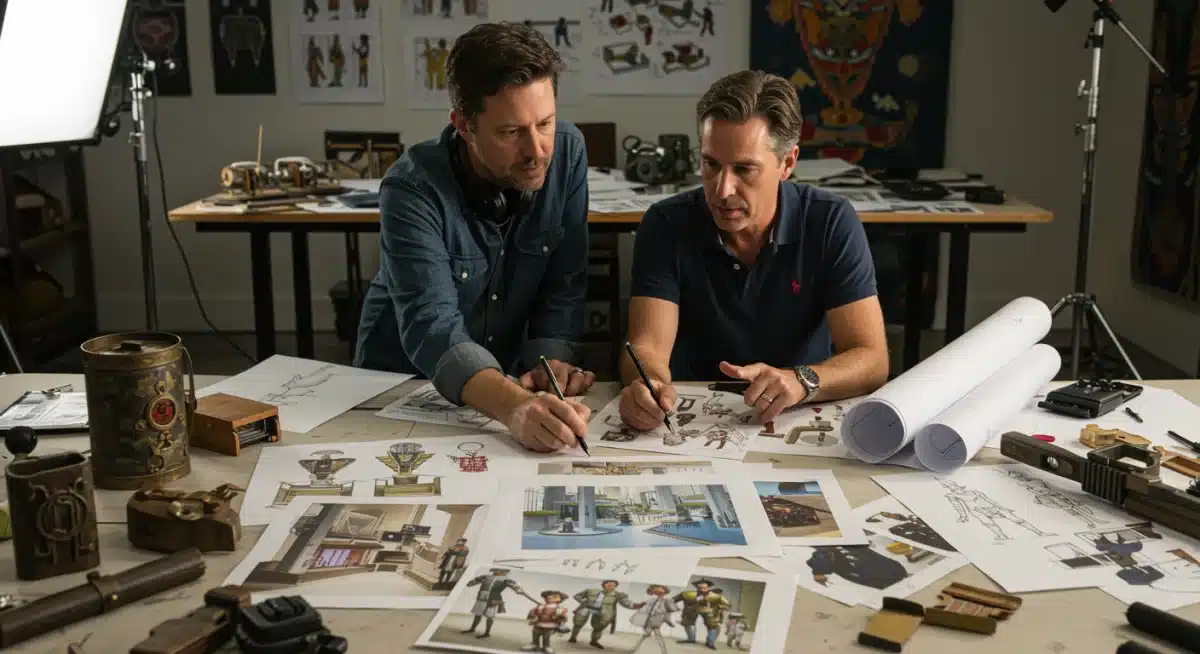Script to Screen: Disney+ Movie Pre-Production Timeline

The 6-month pre-production phase for a Disney+ Original Movie is a complex journey, meticulously orchestrating script refinement, budget allocation, casting, and logistical planning to transform creative vision into cinematic reality.
Understanding the journey From Script to Screen: A 6-Month Timeline of a Disney+ Original Movie’s Pre-Production Phase offers a fascinating glimpse into the intricate world of filmmaking. This critical period lays the groundwork for every visual and narrative element, ensuring that a creative vision can successfully translate into a captivating story for audiences worldwide.
Phase 1: Script Development and Greenlight (Months 1-2)
The initial stage of any Disney+ Original Movie begins with the script. This isn’t just about a good story; it’s about a story that aligns with the Disney+ brand, budget constraints, and target audience. The first two months are dedicated to rigorous script development and securing the coveted ‘greenlight’ for production.
During this period, writers, often working in collaboration with development executives, refine the screenplay, addressing plot holes, character arcs, and dialogue. Multiple drafts are common, each reviewed by a team to ensure it meets the studio’s standards and vision.
Script Refinement and Feedback Loops
The process of refining a script is highly collaborative, involving numerous stakeholders from creative executives to potential directors. Feedback is constant, aiming to strengthen the narrative and ensure it resonates with the intended demographic.
- Initial Drafts: Writers submit their first complete screenplays.
- Executive Reviews: Disney+ creative teams provide detailed notes and suggestions.
- Rewrites: Writers incorporate feedback, often leading to significant structural changes.
- Table Reads: Actors may perform early script versions to identify pacing and dialogue issues.
Securing the Greenlight
Once a script reaches a satisfactory stage, it undergoes a comprehensive evaluation for a greenlight. This decision is based on various factors, including artistic merit, market potential, and financial viability. A detailed budget proposal is also a key component at this stage.
Phase 2: Director Attachment and Key Crew Assembly (Month 3)
With a greenlit script, the focus shifts to bringing the creative leadership on board. Month three is pivotal for attaching the director, whose vision will guide the entire production, and assembling the core creative team that will translate the script into a visual narrative.
The director’s choice is critical, as they are responsible for the artistic and dramatic aspects of the film. Their previous work, stylistic approach, and ability to collaborate are all carefully considered. Once the director is secured, they begin to build their team, starting with key department heads.
Finding the Right Visionary
Disney+ seeks directors who can not only execute the story but also elevate it, bringing a unique perspective while staying true to the brand’s values. This often involves a multi-stage interview process and portfolio reviews.
- Director Shortlist: Identifying potential directors based on genre experience and artistic style.
- Interviews and Pitches: Directors present their vision for the film.
- Negotiation and Contract: Finalizing agreements with the chosen director.
Building the Core Creative Team
The director then collaborates with the studio to select essential crew members. These individuals are crucial for shaping the film’s aesthetic and practical execution.
The production designer, for instance, conceptualizes the film’s visual world, from sets to props, working closely with the director to ensure their vision is realized. The cinematographer is responsible for the film’s visual language, lighting, and camera work, playing a vital role in setting the mood and tone of each scene. Other key hires include the casting director, line producer, and costume designer, each bringing specialized expertise to the project.
Phase 3: Budgeting, Scheduling, and Location Scouting (Month 4)
Month four is characterized by intense logistical planning. This phase involves meticulous budgeting, creating a detailed production schedule, and identifying suitable filming locations. These elements are interdependent; a change in one often necessitates adjustments in the others.
The line producer takes center stage, translating the script’s needs into tangible financial and temporal resources. Every element, from crew salaries to equipment rentals, is factored into the budget, aiming for efficiency without compromising creative quality.
Financial Blueprint: The Budget
Developing the budget is an exhaustive process, breaking down every conceivable cost associated with the film. This financial blueprint guides all subsequent decisions.
- Detailed Cost Breakdown: Allocating funds for cast, crew, locations, equipment, post-production, etc.
- Contingency Planning: Setting aside funds for unforeseen expenses.
- Approval Process: Securing final budget approval from Disney+ executives.
Crafting the Production Schedule
The production schedule is a complex document that maps out every day of filming, including pre-production activities, principal photography, and post-production. It’s designed to maximize efficiency and keep the project on track.
Simultaneously, the location scout team begins their search for settings that match the script’s descriptions and the director’s vision. This can involve scouting diverse environments, from urban landscapes to remote natural areas, both domestically and internationally. Factors such as accessibility, local permits, and potential logistical challenges are all weighed carefully.
Phase 4: Casting and Concept Art Development (Month 5)
As the production machinery gains momentum, month five focuses on bringing the characters to life through casting and visually defining the film’s world through concept art. These processes run concurrently, each informing the other to create a cohesive artistic direction.
The casting director, in close collaboration with the director and producers, identifies actors who embody the essence of the characters. This involves auditions, screen tests, and careful consideration of chemistry between cast members. For a Disney+ Original, finding talent that resonates with a broad, family-friendly audience is paramount.
The Art of Casting
Casting is more than just finding actors; it’s about finding the right personalities and talents to elevate the story.
- Character Breakdowns: Creating detailed descriptions of each role.
- Auditions and Callbacks: Evaluating potential actors through readings and screen tests.
- Chemistry Reads: Testing interactions between lead actors.
- Offers and Negotiations: Securing talent for the film.
Visualizing the World: Concept Art
Concept artists are integral in this phase, translating the script’s descriptions and the director’s vision into stunning visual representations. These artworks serve as a blueprint for production designers, costume designers, and visual effects teams.
From character designs to elaborate set pieces and fantastical creatures, concept art helps to solidify the film’s aesthetic and ensures everyone on the team shares a common visual understanding. This iterative process allows for experimentation and refinement before physical production begins, saving significant time and resources down the line.

Phase 5: Pre-Visualization and Storyboarding (Month 6, Weeks 1-2)
The final weeks of pre-production are dedicated to highly detailed visual planning, ensuring every shot and sequence is meticulously mapped out. This involves pre-visualization (pre-vis) and storyboarding, critical steps in translating the screenplay into a clear cinematic plan.
Pre-vis utilizes 3D animation to create rough versions of complex scenes, especially those involving visual effects or intricate stunt work. This allows the director to experiment with camera angles, blocking, and timing before committing to physical production, significantly reducing costs and potential reshoots.
Mapping the Visual Narrative
Storyboards are sequential drawings that depict each shot of the film, acting as a comic book version of the movie. They are essential for communicating the director’s vision to the entire crew.
- Scene Breakdowns: Dividing the script into individual shots.
- Drawing Panels: Illustrating key moments and camera movements.
- Director Approval: Ensuring alignment with the overall artistic vision.
The combination of pre-vis and storyboards provides a comprehensive visual guide for the crew, from the cinematographer to the special effects team. It allows for early identification of potential challenges and facilitates creative problem-solving, ensuring a smoother transition into principal photography.
Phase 6: Final Preparations and Set Construction (Month 6, Weeks 3-4)
The last two weeks of the 6-month pre-production timeline are a flurry of activity, as all the planning culminates in the physical construction of sets and final logistical arrangements. This is the stage where the theoretical becomes tangible, preparing for the imminent start of principal photography.
Construction crews work tirelessly to build sets based on the approved designs and concept art. From elaborate soundstage builds to practical on-location dressing, every detail is crafted to immerse the audience in the film’s world. Simultaneously, departments like costumes, props, and hair and makeup finalize their respective elements, ensuring everything is ready for the cast and crew.
Building the World: Set Construction
The construction phase is a testament to the meticulous planning that precedes it. Precision and adherence to design are key.
- Blueprint Execution: Translating architectural plans into physical structures.
- Material Sourcing: Acquiring all necessary construction materials.
- Safety Checks: Ensuring all sets meet safety standards for cast and crew.
Logistical Finalization
Beyond the physical sets, a myriad of other preparations are finalized. This includes confirming travel and accommodation for cast and crew, securing necessary permits for filming locations, and ensuring all equipment is on-site and in working order. Wardrobe fittings, makeup tests, and camera tests are also conducted during this period to ensure continuity and desired aesthetic.
This intense final push signifies the successful completion of the pre-production phase, setting the stage for the highly anticipated commencement of principal photography. The seamless coordination during these weeks is crucial for maintaining the production schedule and budget integrity as the project moves into its next major stage.
| Key Phase | Brief Description |
|---|---|
| Script & Greenlight | Months 1-2 focus on refining the screenplay and securing studio approval. |
| Director & Crew | Month 3 involves attaching the director and assembling key department heads. |
| Budgeting & Locations | Month 4 is dedicated to financial planning, scheduling, and scouting film sites. |
| Casting & Visuals | Month 5 focuses on casting actors and developing concept art/storyboards. |
Frequently Asked Questions About Disney+ Movie Pre-Production
The greenlight process can vary significantly depending on the project’s complexity and strategic importance. Generally, it can take several weeks to a few months, involving multiple reviews and approvals from various executive levels within Disney+ and Disney Studios. It’s a critical decision point that ensures alignment with the platform’s vision and financial goals.
The line producer is crucial during pre-production, acting as the primary manager of the film’s budget and schedule. They oversee all physical aspects of the production, ensuring that resources are allocated efficiently and that the project stays on track financially and logistically. Their expertise is vital for turning the creative vision into a practical plan.
Location scouting for a Disney+ Original Movie involves a dedicated team that searches for sites matching the script’s requirements and the director’s aesthetic vision. Factors considered include visual appeal, logistical feasibility, local permits, budget, and potential impact on the production schedule. Both practical locations and studio soundstages are evaluated.
Pre-visualization, or pre-vis, uses basic 3D animation to create rough versions of complex scenes before filming. It’s important because it allows directors and cinematographers to experiment with camera angles, blocking, and visual effects sequences in a cost-effective manner. This helps to iron out creative and technical challenges long before principal photography begins, saving time and money.
Following the intensive 6-month pre-production phase, the project moves directly into principal photography. This is the stage where the actual filming takes place, with the cast and crew executing the meticulously planned shots and sequences. The detailed groundwork laid during pre-production is essential for a smooth and efficient shooting schedule, leading eventually to post-production and release.
What Happens Next
As the final weeks of pre-production conclude, the entire team shifts its focus to the imminent start of principal photography. This transition marks a critical point where all the meticulous planning, creative decisions, and logistical arrangements converge on the film set. The success of the upcoming shooting schedule will largely depend on the thoroughness of these initial six months. Industry observers will now watch for casting announcements, official production start dates, and initial glimpses from the set, all indicative of a project moving closer to its Disney+ debut. The foundation has been laid; the camera is about to roll.